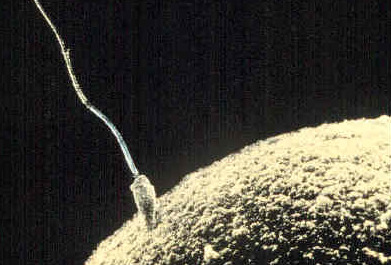GCSE Biology - AQA
1.2.2 - Sperm Cells
Jump to:
Sperm Cells
The function of a sperm cell is to fuse with an egg cell in the process of sexual reproduction in order to create a new individual.
Sperm cells and egg cells are sex cells. During sexual reproduction, an egg cell and a sperm cell fuse to form a cell called a zygote which then develops into the new individual.

Fertilisation occurs when an egg cell and sperm cell fuse to form a cell called a zygote, which is the first cell of a new individual.

Microscope image of a sperm cell and an egg cell fusing together.
Adaptations of sperm cells
A sperm cell is shown below:

A sperm cell.
Like all specialised cells, sperm cells are adapted for their function. In other words, they have structural features that allow them to carry out their function effectively.
The adaptations of sperm cells include the following:
| Adaptation | How it enables a sperm cell to carry out its function of fusing with an egg cell |
|---|---|
| It has a tail. | This allows it to swim to the egg cell. |
| It has many mitochondria. | These release energy - through aerobic respiration - for swimming to the egg cell. |
| It has an acrosome (a special structure found in the head of the cell). | The acrosome contains enzymes which break down the outer layer of the egg cell, allowing the egg and sperm cells to fuse. |
| It has a haploid nucleus (a nucleus with only half the usual number of chromosomes). | Since an egg cell also has a haploid nucleus, this means that when they fuse they form a zygote with the usual number of chromosomes. |
Flashcards
Flashcards help you memorise information quickly. Copy each question onto its own flashcard and then write the answer on the other side. Testing yourself on these regularly will enable you to learn much more quickly than just reading and making notes.
1/7
What is the function of a sperm cell?
2/7
What adaptations does a sperm cell have that enable it to carry out its function?
3/7
How does a sperm cell's tail enable it to carry out its function?
4/7
How do a sperm cell's many mitochondria enable it to carry out its function?
5/7
What is an acrosome and how does it enable a sperm cell to carry out its function?
6/7
What is a haploid nucleus?
7/7
How does having a haploid nucleus enable a sperm cell to carry out its function?
Next Page
1.2.3 - Nerve Cells
Previous Page
1.2.1 - Introduction to Specialised Cells
Return to course page
Donate
Please consider donating to support Mooramo. I am one person doing this whole project on my own - including building the site, writing the content, creating illustrations and making revision resources. By making a one-time or repeating donation you will buy me time to work on Mooramo, meaning that I can get new content on here more quickly.
Donate